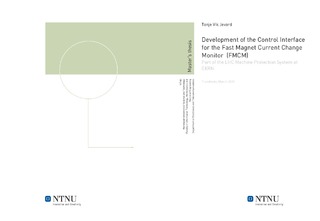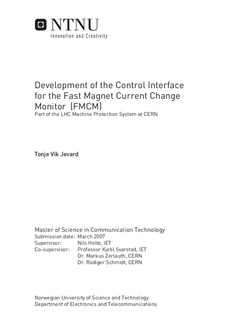| dc.contributor.advisor | Holte, Nils | nb_NO |
| dc.contributor.author | Jevard, Tonje Vik | nb_NO |
| dc.date.accessioned | 2014-12-19T13:43:20Z | |
| dc.date.accessioned | 2015-12-22T11:40:48Z | |
| dc.date.available | 2014-12-19T13:43:20Z | |
| dc.date.available | 2015-12-22T11:40:48Z | |
| dc.date.created | 2010-09-03 | nb_NO |
| dc.date.issued | 2007 | nb_NO |
| dc.identifier | 347441 | nb_NO |
| dc.identifier.uri | http://hdl.handle.net/11250/2369057 | |
| dc.description.abstract | A large number of magnets, both superconducting and normal conducting, are installed for the guidance of the two proton beams around the Large Hadron Collider (LHC), the world's largest particle accelerator currently under construction at the European Organization for Nuclear Research (CERN). Due to the unprecedented energies stored in the beams and the magnets, sophisticated systems are under development to protect the equipment in case of failure. However, scenarios have been identified where failures in the magnet powering will lead to very fast beam losses in less than 100 $mu$s, due to the low time constants of the electrical circuits and the consequent fast current decay. For these circuits, systems that are currently deployed will not be fast enough to generate and transmit a beam dump request before the magnetic field change affects the beam trajectory. A dedicated system for the detection of such fast failures is already operational at the Hadron-Electron Ring Accelerator (HERA) in Hamburg. This system, the Fast Magnet Current Change Monitor (FMCM), has been adapted to meet CERN requirements and needs to be integrated into the CERN accelerator environment. For remote monitoring and Post Mortem analysis every FMCM is connected to the CERN control system by means of an RS-422 interface. This master's thesis is focused on the software development and analysis of the control interface for the described FMCM units. The communication between the FMCMs and the CERN control system has been designed and implemented in C++, following the guidelines given by the Front End Software Architecture (FESA) framework. An analysis of the RS-422 interface with respect to Signal Integrity and Electromagnetic Compatibility verified the current setup of the RS-422 serial interface for the given transmission parameters. Transient bursts are considered to be the most common type of disturbance in the LHC and the related surface buildings. Hence, error detection has been implemented to ensure reliable communication by causing retransmissions of the data until it has been correctly received. | nb_NO |
| dc.language | eng | nb_NO |
| dc.publisher | Institutt for elektronikk og telekommunikasjon | nb_NO |
| dc.subject | ntnudaim | no_NO |
| dc.title | Development of the Control Interface for the Fast Magnet Current Change Monitor (FMCM): Part of the LHC Machine Protection System at CERN | nb_NO |
| dc.type | Master thesis | nb_NO |
| dc.source.pagenumber | 113 | nb_NO |
| dc.contributor.department | Norges teknisk-naturvitenskapelige universitet, Fakultet for informasjonsteknologi, matematikk og elektroteknikk, Institutt for elektronikk og telekommunikasjon | nb_NO |

